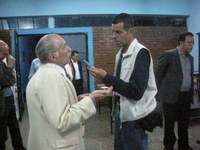How to include wage data from countries that have a huge informal sector, a low internet penetration, and a limited economic development? That is one of the major challenges for the WageIndicator. In Guatemala and Paraguay the WageIndicator showed it is possible to include those countries into its network of now 46 national WageIndicators. The projects started in 2008 with the support of trade unions in both countries. Both countries now have salary checkers for a wide range of occupations.
Online and offline
"In both countries, we did an survey offline, besides an online one," says Victor Beker, project leader of the WageIndicator in Latin America. "This allowed us to cover some occupations not reached by the Internet survey."
Although the number of internet users in both countries is fairly low, with a penetration grade of no more than 15 percent, the number of unique users now visiting both WageIndicator websites is rather high, 4,500 per month Tusalario.org/Guatemala and 3,200 for Tusalario.org/Paraguay. Half of this web traffic comes from the countries themselves.
"What is even more important is that our partners in both countries, the trade unions, are very happy about the WageIndicator project," says Paulien Osse, director of the WageIndicator Foundation.
Mobile
For countries with a huge informal sector and low internet penetration, offline surveys will be held every two to five years, says Paulien Osse. "There is no other alternative in those countries." And although some people think that Salary Surveys can be done with a mobile phone, we think that isn't an option for now. Mobile phones in these countries are wider spread then computers, but that doesn't mean that the phones can be used for surveying. They could be used to give information about a salary indication or a minimum figure. That is basiscally a message you could send by sms." While most people in Guatemala and Paraguay have a mobile phone, for cost reasons they mostly use the SMS-function.
More than 100 hours
Especially in the informal sector, best illustrated in the figures from Paraguay, income tend to be rather low. And the reality might even be worse than the figures show, says Victor Beker. "In both countries many people work more than 100 hours a week. So, in some cases wages per hour may be even worse than what you can read from the annual income. Food vendors would work 7 days per week, at least 12 hours per day."
"Take bus drivers in Guatemala," adds Paulien Osse. "They have a very tough life. They work 100 hours per week, because they have to pay back the debts on their bus. And on top of that, they have a fair chance of getting shot, too."
In the chart we have chosen for the annual income per occupation, but working hours vary greatly.
For most occupations women earn less than men. But the gender gap is dwarfed by the differences between the occupations. Especially, the figures on the informal economy in Paraguay on hairdressers and food vendors show the bottom end of the economy. On the positive side, the occupations who are more directly connected with the international economy, in textile and transportation, are both in Paraguay and Guatemala on a similar level, close to the average income of the country according to the IMF ranking for 2009. Occupations connected to the local economy in Paraguay, both in the informal and formal sector (primary school teachers), tend to be much lower.
More research, into more occupations and more countries in the region would be needed to confirm or discount such a possible positive trend of the globalizing economy.
| Occupation | GTmale | GTfem | PYmale | PYfem |
| primary school teacher |
5520 | 5088 | 1574 | 1511 |
| Sewer (textile) | 3145 | 2613 | 2656 | 2601 |
| Truck driver | 4076 | x | 3627 | x |
| Food vendor | x | x | 44 | 41 |
| hairdresser | x | x | 146 | 121 |
| IT technician | x | x | 1203 | x |
| Bus driver | 2734 | x | 3215 | x |
| Taxi driver | 4947 | x | x | x |
| Adm secretary | x | 1798 | x | x |
| Nursing assist. | 4543 | 4352 | x | x |
| av income (2009) | 4882 | 4882 | 4551 | 4551 |
Source: TuSalario for Guatemala and Paraguay., IMF
Guatemala/Paraguay data
| GT | PY | |
| Population | 13 m | 7 m |
| surface | 110,000 km2 | 400,000 km2 |
| av income(2009) | USD 4,882 | USD 4,551 |
| GDP | 69 bn USD | 28 bn USD |
| Growth(2009) | 0.5% | -3.5% |
| labor force | 4 m | 3 m |
Are you interested in what you should be earning in your country? Go to our overview of salary checks. We have now new salary checks for Belarus and Indonesia. You can meet our team for Latin America here.

